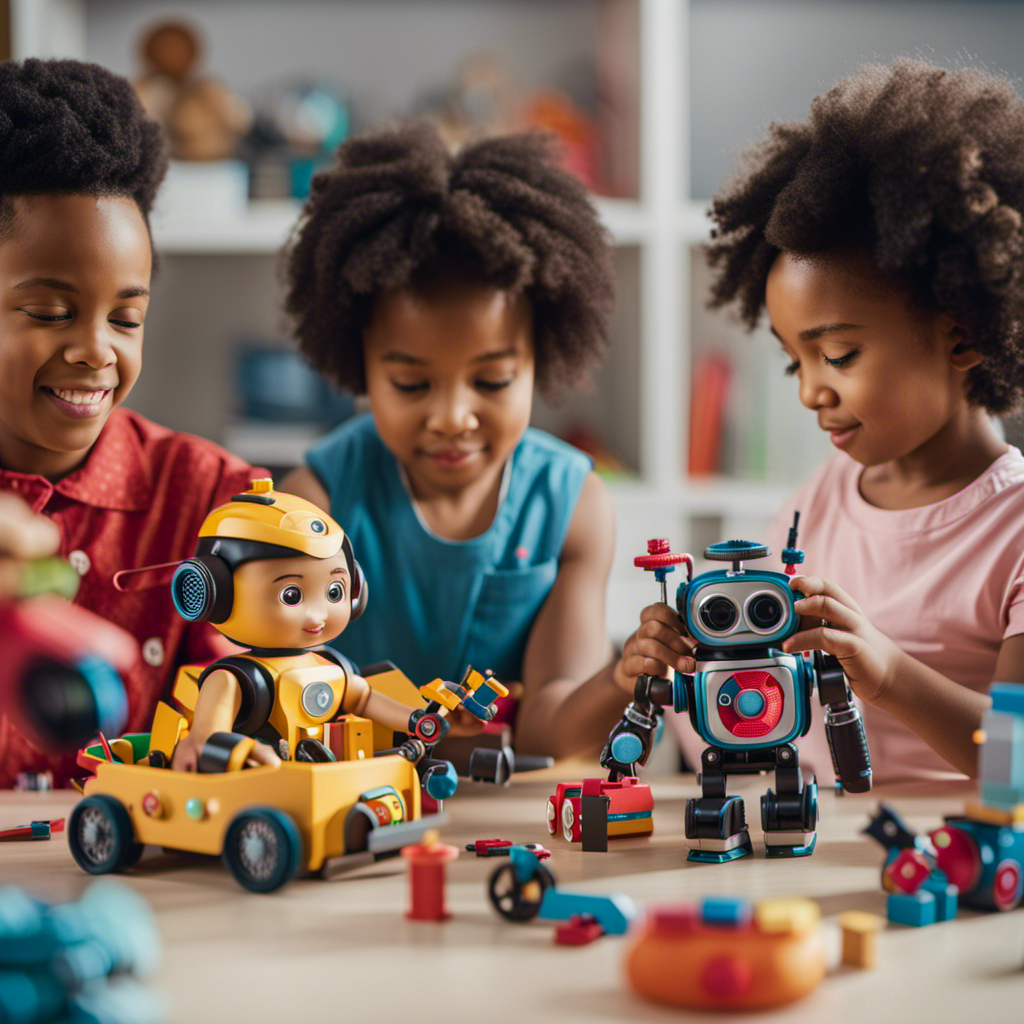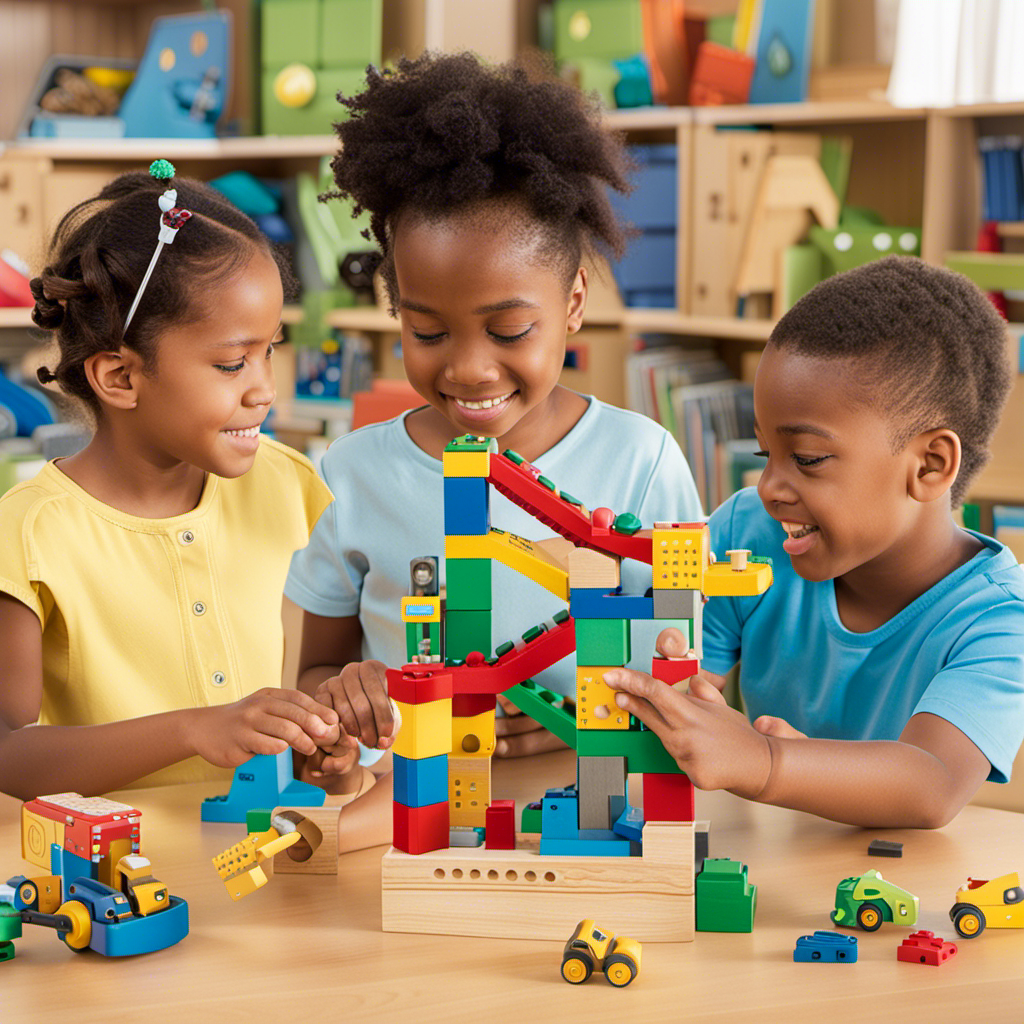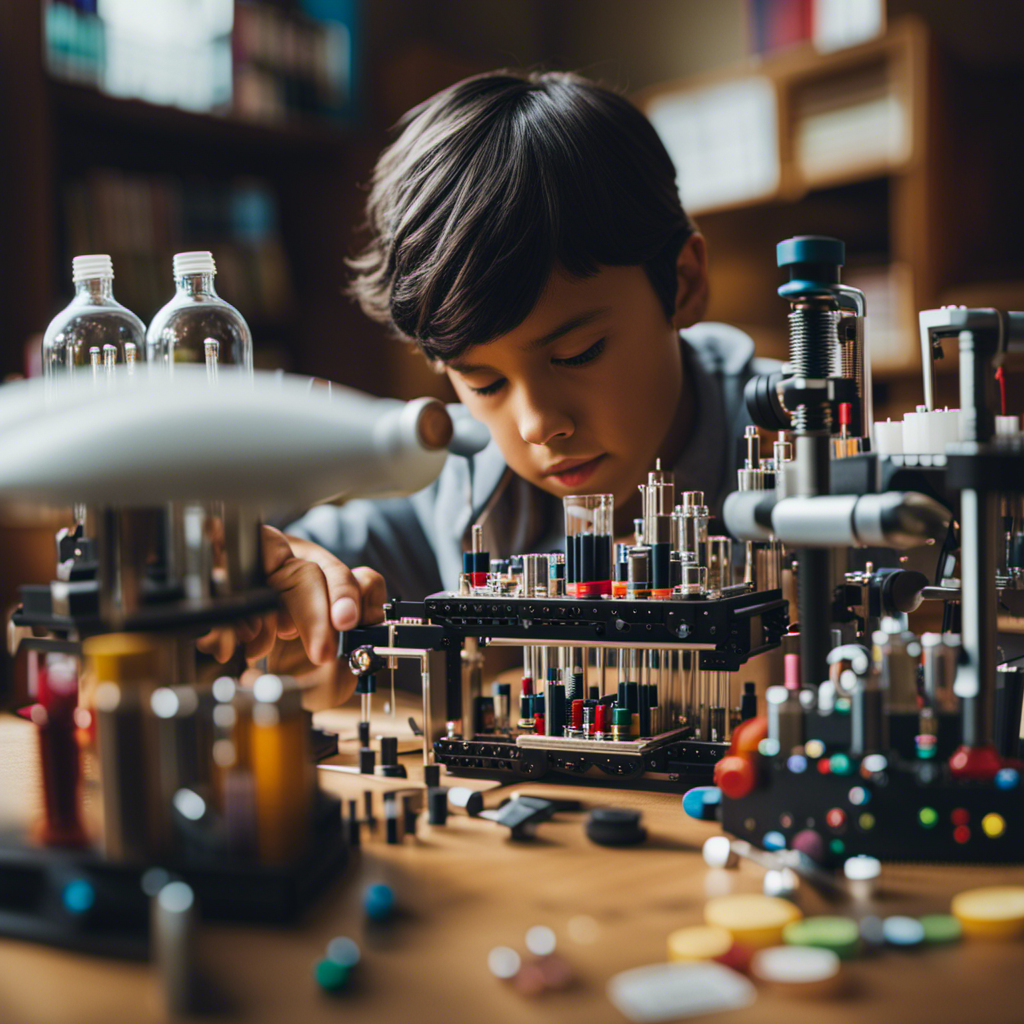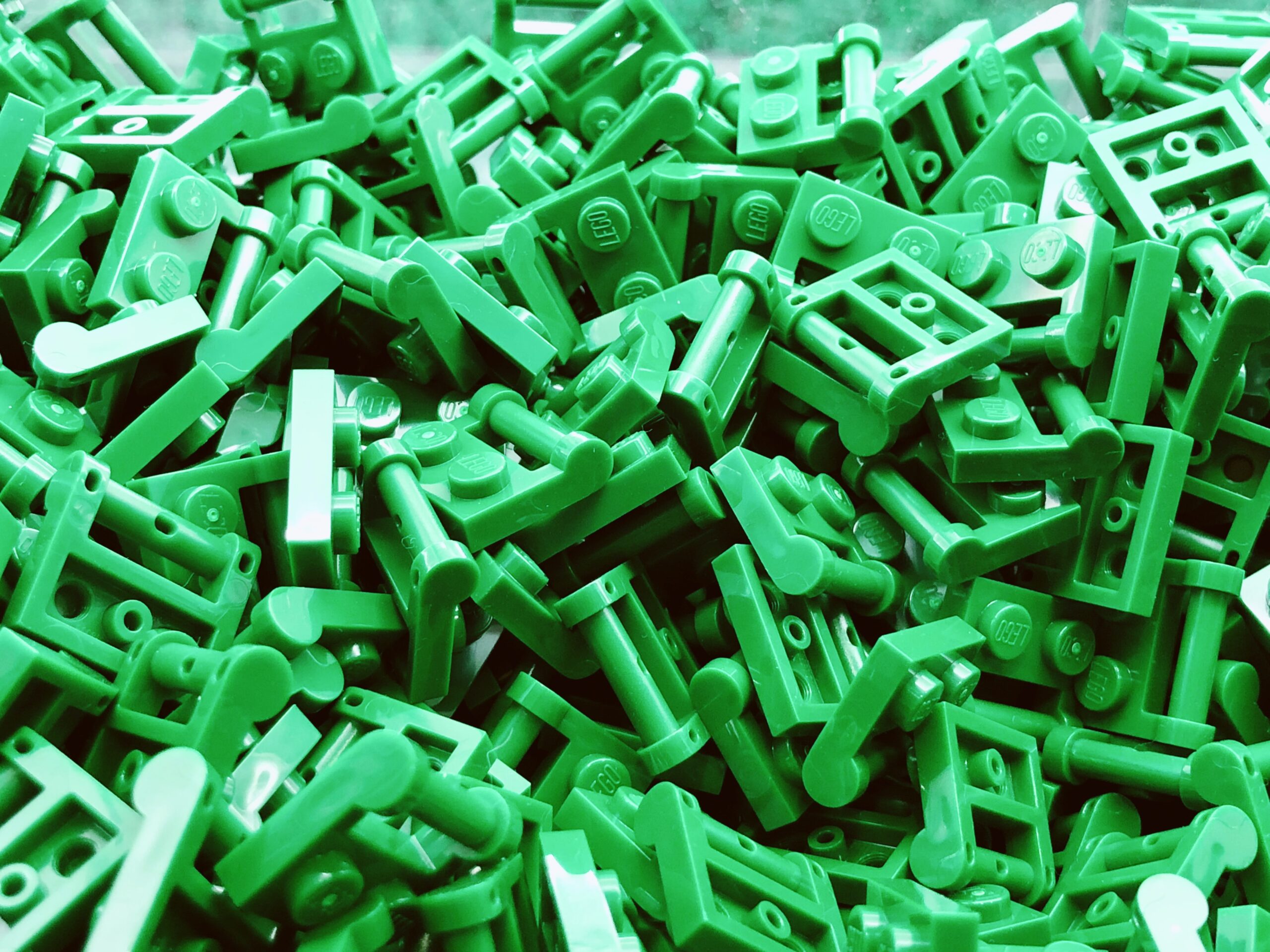It is interesting to examine the complex connection between toys and how they impact gender roles and STEM fields. It is ironic that toys, which are meant to spark creativity and imagination, can also reinforce societal norms and stereotypes.
It is crucial to analyze the historical perspectives, socialization processes, and marketing tactics that contribute to these gendered toy preferences.
By understanding the impact of toys on cognitive development and parental influence, we can begin to challenge these norms and create a more inclusive environment that nurtures all children’s interests and abilities in STEM.
Key Takeaways
- Gendered toy preferences are shaped by societal expectations and limit children’s exposure to STEM toys, impacting their interest in STEM fields.
- Toy marketing reinforces traditional gender norms, creating a clear divide between ‘masculine’ and ‘feminine’ toys and limiting imagination and understanding of the world.
- Parents play a crucial role in shaping toy choices and breaking gender stereotypes, and need to critically analyze the toys they provide for their children.
- Addressing bias in toy design and representation by providing diverse and inclusive toys can promote exploration, diversity, and inclusivity in play and beyond.
Historical Perspectives on Gendered Toys and STEM
Historical perspectives on gendered toys and STEM show how societal norms have influenced children’s play and career choices.
When examining the history of gendered toy preferences, it becomes evident that societal expectations have played a significant role in shaping children’s perceptions of what is deemed appropriate for their gender. Throughout history, toys have been designed and marketed in ways that reinforce traditional gender roles.
Girls have been encouraged to play with dolls, tea sets, and domestic toys, while boys have been directed towards construction sets, action figures, and science kits. These gendered toy preferences reflect the societal expectations placed on girls and boys, reinforcing the idea that girls are nurturing and domestic, while boys are logical and adventurous.
This historical context has had a profound impact on children’s play and the career choices they make later in life. By limiting girls’ exposure to STEM-related toys, they are less likely to develop an interest in science, technology, engineering, and mathematics. This lack of exposure perpetuates the gender gap within STEM fields, where women continue to be underrepresented.
Additionally, boys who are discouraged from engaging with toys that are traditionally associated with femininity may miss out on developing important skills such as empathy and emotional intelligence.
Transitioning into the subsequent section about socialization and the impact of toys on gender roles, it is important to understand how these gendered toy preferences contribute to the reinforcement of societal expectations and the perpetuation of gender inequality.
Socialization and the Impact of Toys on Gender Roles
In your everyday life, you might not realize the significant role that toys play in shaping your perception of gender and its impact on your socialization. From an early age, children are exposed to toys that are heavily gendered, reinforcing societal expectations and norms. These toys are not just innocent playthings; they shape our understanding of what it means to be a boy or a girl, and ultimately influence our sense of self and our place in society.
Imagine a world where toy preferences were not limited by gender. Picture a child playing with a dollhouse, fostering their nurturing skills, while also building and fixing things with a toolset. Envision a boy twirling in a princess costume, exploring his creativity and imagination. Picture a girl playing with building blocks, developing her spatial reasoning and problem-solving abilities. Envision a boy playing with a kitchen set, learning valuable life skills. Imagine a girl playing with a construction set, cultivating her engineering and design talents.
Toy preferences are not inherently linked to gender identity. However, the marketing and societal pressures imposed on children heavily influence their toy choices. In the subsequent section, we will explore the influence of toy marketing on gender stereotypes, further unpacking the ways in which toys shape our understanding of gender roles and limit our potential.
The Influence of Toy Marketing on Gender Stereotypes
Imagine how different your perception of gender stereotypes would be if toy marketing didn’t heavily influence your toy choices. Toy marketing tactics have a profound impact on children, shaping their understanding of gender roles from a very young age. The way toys are marketed reinforces traditional gender norms and perpetuates harmful stereotypes.
From a young age, children are bombarded with advertisements and commercials that depict boys playing with action figures and construction sets, while girls are shown playing with dolls and princess-themed toys. These marketing tactics create a clear divide between what is considered ‘masculine’ and ‘feminine,’ limiting children’s choices and reinforcing harmful stereotypes.
The impact of toy marketing on children is significant. It shapes their perception of what is acceptable for their gender and influences their cognitive development. When children are consistently exposed to gendered toy preferences through marketing, it can restrict their imagination and limit their understanding of the world. This can have long-lasting effects on their self-esteem, confidence, and future career aspirations.
Transitioning into the subsequent section about cognitive development and gendered toy preferences, it is crucial to explore the ways in which toy marketing influences children’s understanding of gender stereotypes and how this impacts their cognitive development.
Cognitive Development and Gendered Toy Preferences
When it comes to cognitive development and gendered toy preferences, the debate of nature versus nurture is at the forefront.
While some argue that biological factors play a significant role in determining toy preferences, others believe that socialization and cultural norms heavily influence these choices.
Additionally, the impact of these toy preferences on career aspirations cannot be ignored, as they can perpetuate gender stereotypes and limit opportunities for children based on their assigned gender.
Nature Vs. Nurture?
You might wonder if your interests and abilities are shaped more by nature or nurture. When it comes to gender identity, this debate becomes even more complex. Here are three key points to consider in the nature vs. nurture discussion:
-
Biological factors: Research suggests that hormones and genetics play a role in shaping gender identity. For example, studies have found differences in brain structure and function between cisgender and transgender individuals.
-
Socialization: While biology may contribute, societal norms and expectations heavily influence gender identity. From a young age, children are exposed to gendered messages through media, toys, and social interactions, which can shape their understanding of themselves and others.
-
Individual agency: It’s important to acknowledge that individuals have agency in determining their own gender identity. While external factors undoubtedly have an impact, personal experiences and self-reflection also play a crucial role.
Understanding the interplay between nature and nurture is vital in comprehending gender identity.
Moving forward, we will explore how socialization and toy choice further influence the development of gender roles and STEM engagement.
Socialization and Toy Choice
The influence of socialization and toy preferences on the development of gender roles and STEM engagement cannot be underestimated. From a young age, children are exposed to societal expectations that shape their toy preferences and ultimately influence their future career aspirations. Toys play a crucial role in the socialization process, as they reflect and reinforce societal norms and expectations. Boys are often encouraged to play with construction sets and toy cars, fostering spatial and mechanical skills that align with STEM fields. Meanwhile, girls are encouraged to play with dolls and domestic toys, reinforcing traditional gender roles and limiting their exposure to STEM-related activities. This stark divide in toy preferences perpetuates stereotypes and hinders opportunities for girls to explore their interest in STEM. These societal expectations have far-reaching consequences, impacting girls’ career aspirations and limiting their potential in the STEM fields.
| Boys’ Toy Preferences | Girls’ Toy Preferences |
|---|---|
| Construction sets | Dolls |
| Toy cars | Domestic toys |
| Science kits | Dress-up costumes |
| Robots | Tea sets |
Transitioning into the next section, the impact of these societal expectations on career aspirations is significant.
Impact on Career Aspirations
Exposure to societal expectations regarding toy preferences can greatly shape your career aspirations. The impact of these expectations on educational attainment and career choices is significant, as it perpetuates gender stereotypes and limits opportunities for growth and development. Here are three ways in which the influence of toys on career aspirations is detrimental:
-
Reinforcing traditional gender roles: Toys that promote domesticity and nurturing for girls, and construction and problem-solving for boys, reinforce the idea that certain careers are suitable only for specific genders, limiting their potential.
-
Narrowing career options: When children are exposed to limited toy options based on their gender, they may not explore a wide range of interests and careers, leading to a narrower scope of possibilities later in life.
-
Undermining confidence: Toys that prioritize physical appearance or reinforce stereotypes can erode a child’s confidence in pursuing careers that challenge these ideals, hindering their educational and professional growth.
As we delve into the role of parents in shaping toy choices and gender roles, it becomes evident that their influence is pivotal in challenging and reshaping these societal expectations.
The Role of Parents in Shaping Toy Choices and Gender Roles
Parents play a crucial role in shaping their children’s toy choices and influencing the development of gender roles. From an early age, parents heavily influence the toys their children play with, often unknowingly reinforcing societal expectations and stereotypes. This can have long-lasting effects on children’s perceptions of gender and their future career aspirations. As a parent, it is important to critically analyze the toys we provide for our children and consider how they may contribute to the reinforcement of traditional gender roles.
To better understand the impact of parents’ influence on toy choices, let’s take a look at a table that highlights some common toys and the gender expectations associated with them:
| Toy | Gender Expectation |
|---|---|
| Dolls | Girls |
| Cars | Boys |
| Building Sets | Boys |
| Cooking Sets | Girls |
| Science Kits | Boys |
This table clearly shows how certain toys are often marketed towards specific genders, reflecting societal expectations. When parents adhere to these norms and limit their children’s toy choices based on gender, they inadvertently limit their child’s potential by reinforcing traditional gender roles.
As we delve into the subsequent section about toys as tools for promoting STEM skills in girls and boys, we will explore how breaking free from societal expectations can open up new possibilities for our children’s future.
Toys as Tools for Promoting STEM Skills in Girls and Boys
I believe that breaking gender stereotypes and encouraging equal opportunities is crucial in today’s society. By challenging traditional gender roles and expectations, we can create a more inclusive environment that allows individuals to pursue their interests and talents regardless of their gender.
This is especially important when it comes to providing equal opportunities in education, career choices, and personal growth.
Breaking Gender Stereotypes
Toys can play a significant role in breaking down gender stereotypes and promoting inclusivity. By offering children a diverse range of play options, toys can challenge traditional notions of what is considered ‘appropriate’ for boys or girls. When children are exposed to a variety of toys that don’t adhere to gender norms, they are encouraged to explore different interests and abilities. This allows them to develop a more well-rounded understanding of themselves and others, fostering empathy and understanding.
However, it is essential to recognize that breaking down gender stereotypes in toys is just one step towards achieving true gender equality. Encouraging equal opportunities for all children, regardless of their gender, goes beyond the realm of play and extends to education, career choices, and societal expectations.
Encouraging Equal Opportunities
By offering children diverse play options, we can encourage equal opportunities, breaking down societal expectations and promoting inclusivity. Parental influence plays a crucial role in shaping children’s perceptions of gender roles. When parents provide children with toys that challenge traditional gender norms, they open up a world of possibilities and empower them to explore their interests freely.
Toys that promote STEM (science, technology, engineering, and math) play a significant role in this aspect, as they encourage critical thinking, problem-solving skills, and creativity. Moreover, incorporating STEM toys into a child’s playtime can have a profound educational impact, fostering a love for learning and preparing them for future careers.
Addressing Bias in Toy Design and Representation
Addressing bias in toy design and representation can help promote diversity and inclusivity. Toys play a significant role in shaping children’s understanding of gender roles and can perpetuate harmful stereotypes. By addressing toy bias, we have the opportunity to create a more inclusive environment where children can explore and express their interests without limitations based on societal expectations.
Promoting inclusivity means designing toys that break free from traditional gender norms. For instance, dolls can be made to represent a diverse range of races, body types, and abilities. By doing so, children can see themselves reflected in their toys, fostering a sense of belonging and self-worth. Additionally, providing toys that challenge traditional gender roles, such as construction sets for girls and nurturing dolls for boys, can encourage children to explore different interests and develop a broader understanding of their own capabilities.
Transitioning into the subsequent section about the importance of play in developing STEM interest and abilities, it is essential to recognize that toys are not just for entertainment. Play is a crucial tool for children to learn and develop skills. By introducing STEM-related toys that are inclusive and accessible to all genders, we can spark and nurture an early interest in science, technology, engineering, and mathematics. This can lead to a more diverse and inclusive future in STEM fields, breaking down gender barriers and creating equal opportunities for all.
The Importance of Play in Developing STEM Interest and Abilities
In the previous section, we discussed the need to address bias in toy design and representation. Now, let’s shift our focus to the importance of play in developing STEM interest and abilities. As a parent, I understand the vital role we play in fostering our children’s interest in STEM fields.
Here are three key points to consider:
-
Early exposure: Introducing children to STEM concepts through play at a young age can have a lasting impact on their cognitive development. Providing them with toys that encourage problem-solving, critical thinking, and creativity can lay a strong foundation for future STEM exploration.
-
Hands-on experimentation: Play allows children to engage in hands-on experimentation, which is crucial for developing their scientific inquiry skills. Toys that promote exploration, such as building blocks or science kits, can enhance their understanding of concepts like cause and effect, hypothesis testing, and data analysis.
-
Parental involvement: Parents can actively participate in their child’s play and provide guidance and support. By engaging in STEM-related activities together, we can foster a positive attitude towards these fields and show our children that we value their interests.
Now, let’s move on to the next section, where we will explore how toy selection can encourage girls’ participation in STEM.
Encouraging Girls’ Participation in STEM Through Toy Selection
As we continue to explore the importance of play in developing STEM interest and abilities, it is essential to address the issue of breaking gender stereotypes in toy selection.
The responsibility falls on the toy industry to challenge and overturn traditional gender roles within their product offerings. By creating inclusive and diverse toys that defy societal expectations, the industry can foster an environment where all children, regardless of their gender, feel empowered to explore and excel in STEM fields.
Breaking Gender Stereotypes
You can challenge gender stereotypes by encouraging your child to play with a variety of toys. By providing them with gender-neutral toys and promoting inclusivity, you can help break down the barriers that limit their potential based on societal expectations. Gender-neutral toys not only allow children to explore different interests and skills, but they also foster creativity, problem-solving, and empathy. It’s important to recognize that children should have the freedom to choose the toys they are drawn to, regardless of their gender.
To better understand the impact of gender-neutral toys, let’s take a look at the following table:
| Gender-Neutral Toy | Benefits | Examples |
|---|---|---|
| Building Blocks | Develops spatial skills and problem-solving abilities | LEGO, Magna-Tiles |
| Art Supplies | Encourages creativity and self-expression | Paints, crayons, markers |
| Science Kits | Nurtures curiosity and critical thinking | Microscope kits, chemistry sets |
As you can see, gender-neutral toys offer a wide range of advantages for children. However, it is not solely the responsibility of parents to challenge gender stereotypes. The toy industry also plays a crucial role in promoting inclusivity and breaking down gender barriers.
Toy Industry’s Responsibility
The responsibility of the toy industry is to promote inclusivity and break down gender barriers by offering a diverse range of toys for children to choose from. However, the toy industry’s impact on gender roles and stereotypes cannot be overlooked.
Gendered marketing has long perpetuated the idea that certain toys are only suitable for boys or girls. This narrow approach limits children’s options and reinforces harmful stereotypes. It is crucial for the toy industry to recognize and challenge these gender norms.
Breaking Down Gender Barriers in Toy and STEM Industries
When it comes to breaking down gender barriers in the toy and STEM industries, it’s important to recognize the impact that inclusive marketing and representation can have. By promoting gender neutral toys and promoting diversity in STEM careers, we can create a more inclusive and equitable society.
Here are five key reasons why this is crucial:
-
Challenging stereotypes: By offering a diverse range of toys that are not limited to traditional gender roles, we can challenge harmful stereotypes and encourage children to explore a wider range of interests and career paths.
-
Encouraging creativity: Gender neutral toys allow children to play freely and use their imagination without being confined by societal expectations. This can foster creativity and innovation, essential skills for success in any field.
-
Fostering inclusivity: By representing diverse genders, races, and abilities in STEM-related toys and media, we can make these industries more accessible and welcoming for everyone, regardless of their background.
-
Breaking down barriers: By promoting diversity in STEM careers, we can break down the barriers that have historically excluded marginalized groups from these fields. This can lead to more innovation and progress.
-
Creating a more equitable future: By providing equal opportunities for all children to engage with STEM toys and pursue STEM careers, we can work towards a more equitable society where everyone has a chance to succeed.
Strategies for Creating Gender-Inclusive Toy Spaces and STEM Programs
Try incorporating diverse representation and inclusive marketing strategies to create toy spaces and STEM programs that are gender-inclusive and welcoming for all. Creating inclusive environments and promoting diversity in STEM is crucial for breaking down gender barriers and ensuring equal access and opportunities for everyone. By embracing diverse representation in toys and STEM programs, we can challenge traditional gender norms and stereotypes, while also encouraging children of all genders and backgrounds to explore their interests and potentials in science, technology, engineering, and mathematics.
To illustrate the importance of inclusive toy spaces and STEM programs, let’s take a look at the table below:
| Gender-Inclusive Toys | Gender-Inclusive STEM Programs |
|---|---|
| Dolls with diverse body types, abilities, and genders | STEM workshops that highlight the contributions of diverse scientists and engineers |
| Building sets that promote collaboration and creativity | Robotics clubs that encourage girls and non-binary individuals to participate |
| Science kits that explore a wide range of topics | Mentorship programs that provide support and guidance for underrepresented groups |
| Board games that celebrate diversity and inclusivity | Coding camps that prioritize accessibility and inclusion |
| Art and craft kits that encourage self-expression | Science fairs that showcase projects from students of all backgrounds |
Frequently Asked Questions
Are There Any Historical Examples of Gender-Neutral Toys Being Popular?
I’m not sure about historical examples of gender-neutral toys being popular.
However, it’s important to consider the impact of gender-neutral toys on children’s self-esteem.
By providing toys that are not limited to traditional gender roles, we can challenge societal norms and promote inclusivity.
This can help children develop a more holistic understanding of gender and encourage them to pursue diverse interests.
It’s crucial to create an environment that allows children to explore their identities and interests freely.
How Do Toys Impact Children’s Social Development?
Toys play a crucial role in shaping children’s social development. They provide opportunities for learning emotional intelligence and promoting empathy and social skills. Some may argue that toys are merely objects and have no impact on a child’s social development.
However, research shows that toys can influence how children understand and interact with others. By engaging in imaginative play and role-playing with different toys, children learn how to navigate social situations and develop essential social and emotional skills.
What Are Some Ways in Which Toy Marketing Perpetuates Gender Stereotypes?
Gendered toy marketing perpetuates harmful gender stereotypes by reinforcing societal expectations and limiting children’s potential. It influences socialization by suggesting that certain toys are suitable only for girls or boys.
This not only restricts children’s interests but also reinforces gender norms that can hinder their development. For example, marketing dolls and kitchen sets to girls while promoting action figures and building blocks for boys reinforces the idea that caregiving and domesticity are solely feminine traits, while independence and problem-solving are masculine.
How Do Gendered Toys Affect Cognitive Development in Children?
Toys have a profound impact on cognitive development in children. Just like a painter’s brush strokes shape a masterpiece, toys shape young minds.
Gendered toys, however, can limit this development by reinforcing societal stereotypes. Boys are encouraged to play with building blocks and cars, while girls are directed towards dolls and kitchen sets. This narrow focus can hinder the development of essential skills and limit their potential in areas like STEM.
It is crucial to challenge these gendered norms and provide children with a diverse range of toys to foster holistic brain development.
What Can Parents Do to Encourage Their Children to Play With a Wider Range of Toys and Explore Different Interests?
To encourage children to play with a wider range of toys and explore different interests, parents can foster creativity and break stereotypes.
By providing a diverse selection of toys and exposing children to various activities, they can expand their horizons and challenge traditional gender roles.
Encouraging open-ended play and emphasizing the importance of imagination can also promote a well-rounded development.
It is crucial for parents to create an inclusive environment that supports children’s exploration and allows them to grow beyond societal expectations.
Conclusion
In conclusion, it is evident that toys play a significant role in shaping gender roles and influencing children’s interest in STEM fields. According to a study by the National Science Foundation, only 29% of women earn degrees in science and engineering. This statistic highlights the urgent need to address the gender gap in STEM education and careers.
By challenging traditional gender norms and providing children with diverse, inclusive toys, we can foster creativity, curiosity, and a passion for STEM in all children, regardless of their gender. It is crucial for parents, educators, and the toy and STEM industries to work together to break down gender barriers and create a more inclusive and equitable future for all.
Tina is the heart and soul behind Toddler Ride On Toys. With a passion for early childhood education and a deep understanding of child development, Tina ensures that every piece of content on our website reflects our commitment to playful learning. Her expertise in Montessori, Preschool, STEM, and Waldorf education philosophies helps shape our website into a valuable resource for parents, caregivers, and educators.










